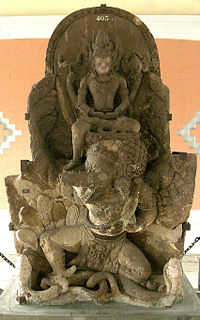National emblem of Indonesia
The Garuda claws gripping a white ribbon scroll inscribed with the national motto Bhinneka Tunggal Ika written in black text, which can be loosely translated as "Unity in Diversity".Garuda Pancasila was designed by Sultan Hamid II from Pontianak, supervised by Sukarno, and was adopted as the national emblem on 11 February 1950.Temples such as Mendut, Borobudur, Sajiwan, Prambanan, Kidal, Penataran, Belahan, and Sukuh depict the images (bas-relief or statue) of Garuda.In the Shiva temple, also in Prambanan complex, there is a relief telling an episode of Ramayana about Garuda's nephew who also belongs to the bird-god race, Jatayu, tried to rescue Sita from Ravana's hand.However, the Islamic party Masyumi expressed their objection and stated that the bird with human neck and shoulders with both hands holding the Pancasila shield was too mythical.On 20 March 1950, Sukarno ordered the palace artist Dullah to make several improvements according to his suggestions, such as the addition of a crest and the change of talons position to the scroll.[7][8] This spirit of religious tolerance was an essential element in the foundation and security of the newly emerging State of Majapahit and the thus fledgling Republic of Indonesia.It is also used in private offices and buildings, also in the classes of public schools, placed on the wall slightly upper than the President's and Vice-President's photographs that flanked the emblem.[11] The controversy also raised from pro-Prabowo musician Ahmad Dhani who campaigned through a music video that displays golden Garuda Pancasila — which looks like the German imperial eagle, in aesthetic imagery reminiscent of Nazi's style fascism.The design of Garuda Pancasila was inspired by the elang Jawa or Javan hawk-eagle (Nisaetus bartelsi), an endangered raptor endemic to the mountainous forest regions of Java.The Javan hawk-eagle's resemblance to the Garuda Pancasila is most obvious with the prominent crest crowning its head and the plumage colored dark-brownish to chestnut-gold.By presidential decree, the Javan hawk-eagle was legally registered as the national bird of Indonesia, and thus attributing the endangered species very high protection.This is a symbol common not only among Indonesia's sanctioned faiths of Islam, Protestantism, Hinduism, Catholicism, Buddhism and Confucianism, as well as among some of the Aliran Kepercayaan (native religions), but of the secular ideology of socialism as well.The Republic of Indonesia, as an ideal conceived by Sukarno and the Nationalists, is one country out of many far-flung cultural roots, made up of millions of people from a number of ethnic communities and groups and from 38 provinces from far west of Sumatra to far east of Papua.'Pancasila March'), colloquially and significantly better known by its incipit Garuda Pancasila, was composed by Sudharnoto as a patriotic song to commemorate the Indonesian struggle.








ArmigerRepublic of IndonesiaPresident of IndonesiaVice President of IndonesiaPeople's Consultative AssemblyRegional Representative CouncilHouse of RepresentativesJudiciary of IndonesiaAudit Board of IndonesiaCabinet of Indonesiadiplomatic missionsprovincial governors, regents, and mayorsShieldPancasilaEquatorbantengbanyanSupportersGarudaJavan hawk-eagleBhinneka Tunggal IkaOld JavaneseUnity in DiversityIndonesia's independence was proclaimedheraldic shieldideologySultan Hamid IIPontianakSukarnoAirlanggaVishnuvahanaHindu godBuddhistMendutBorobudurSajiwanPrambananPenataranRamayanaJatayuRavanaTrowulan MuseumdragonserpentsGaruda IndonesiaIndonesian National Revolutionnational emblemUnited States of IndonesiaPortfolioMuhammad YaminKi Hajar DewantaraMelkias Agustinus PellaupessyMohammad NatsirPoerbatjarakaMohammad HattaJapanese Empire flaganthropomorphicMasyumiAG Pringgodigdobald eagle in the United States Great SealMajapahit Empirelontar manuscriptsIndonesian governmentministriesCorruption Eradication CommissionGeneral Elections CommissionPeople's Representative CouncilsportsIndonesia national football teamGreat Indonesia Movement PartyPrabowo Subianto2014 presidential campaignAhmad DhaniGerman imperial eaglecampaign for presidency2019 electionNational MonumentJakartagolden eagleBalineseemblem of Thailandnaturalistraptornational birdproclamation of Indonesian independenceheraldic termsProtestantismHinduismCatholicismBuddhismConfucianismAliran Kepercayaansocialismmonotheismethnic communities and groupsGolkarDemocracyMegawati SoekarnoputriIndonesian Democratic Party of StrugglecottonArmorial of IndonesiaMohammad YaminRising Sun FlagIndonesiaHatchedArmorial of AsiaEmblems of IndonesiaWikisourceWayback MachinearticlesHistoryTimelinePrehistorySpread of IslamPortuguese eraVOC eraFrench and British eraDutch East IndiesJapanese occupationNational RevolutionLiberal democracy eraGuided Democracy eraTransitional eraNew OrderReformasi
